Collecting intent data enables sales teams to tailor conversations based on a prospect’s current needs, reducing cold calls and improving engagement rates. Understanding how to gather this data is crucial for optimizing telemarketing strategies.
1. Understanding Intent Data and Its Importance collect intent
Intent data refers to information that buy telemarketing data indicates a prospect’s interest or readiness to engage with a product or service. For telemarketing, intent data helps prioritize leads who are more likely to convert, making campaigns more efficient and effective.
2. Tracking Online Behavior and Engagement
One of the primary ways to collect intent data is by monitoring online behavior. This includes tracking website visits, page views, content downloads, webinar registrations, and time spent on product pages. Tools like Google Analytics, marketing estonia phone number list: ethical marketing strategies automation platforms, and CRM integrations can capture these activities, revealing what prospects are interested in.
For example, if a lead frequently visits your pricing page or downloads a product brochure, it signals a higher intent to buy. Telemarketing teams can use these insights to prioritize follow-ups and tailor scripts to address the prospect’s specific interests or concerns.
3. Leveraging Third-Party Intent Data Providers
Many companies also purchase or subscribe to third-party intent data from specialized vendors. These providers aggregate behavioral data from various sources such as industry forums, review sites, and social media, giving insights into when a trust review business or individual is researching products or services similar to yours.
Third-party intent data can help identify prospects showing buying signals even before they interact with your own channels. Integrating this data into your telemarketing platform allows your team to reach out proactively to leads who are actively researching, increasing the chances of conversion.
4. Using Surveys, Feedback, and Direct Interactions collect intent
Collecting intent data can also involve direct input from prospects through surveys, feedback forms, and conversations. During calls or through online forms, asking targeted questions about needs, challenges, and timelines can reveal intent levels.
Additionally, telemarketing agents can gather qualitative intent data during interactions by noting prospect interest, objections, or urgency. This information enriches the database, helping refine segmentation and future outreach strategies.
